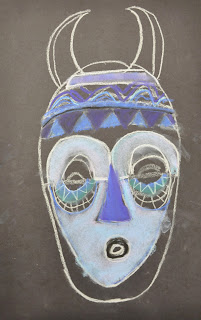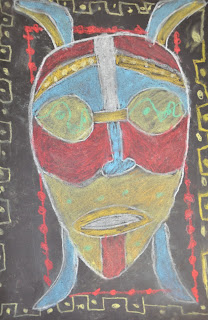Kindergarten- Science: Construction Unit
Objectives:
Students will
combine shapes in a sequence.
Students will construct a castle with squares, rectangles, triangles and circles.
They will use watercolor
washes with a crayon resist to complete the image.
Students will
create a sunset using warm colors.
Michigan Science/ Construction Unit
4. Strong Structures
5. Building with Many Materials
7. Pulleys OR Levers OR both
8. Architecture Walk OR Bridges
Kindergarten- Science/ Natures Collections
The Kindergardener's learned about creating collections. We focused on leaves from trees and how we can collect them. If we collected a lot of leaves we could make a pile of similar leaves and know that they came from the same type of tree. I read Leaves Fall Down and we learned that all leaves have the color green and yellow in them.
Next, students made leaf prints using green and yellow & red and orange. We looked at the color wheel and discussed the different color combinations. Each child was able to tell me the answer to what color would be made by mixing red and blue, yellow and blue, or yellow and red.
Objectives:
To introduce
students to different art methods: crayon resists and printing.
Have students use and apply their knowledge of design to their own work.
Have students use the art materials properly.
Have students demonstrate their ability to create work from observing and memory.
Have students use and apply their knowledge of design to their own work.
Have students use the art materials properly.
Have students demonstrate their ability to create work from observing and memory.
Unit 3: Collections From Nature:
Seek, Find and Share
Think and Wonder
Explore Form and Texture
Sort and Classify
Identify and
Research
First Grade Science- Scientific Illustration
First Grade Science- Scientific Illustration
Matisse's Goldfish was an inspiring piece to show the First Grader as they drew their goldfish in their Science Journal.
Objective:
Students will observe live goldfish in a setting and draw what they see.
Students will be able to create an environment through art.
Second Grade Science- Sound Unit
Second Graders have a Sound Unit they do in conjunction with Music. I have included this concept in Art. Students created a Turtle Rattle as part of a Humanities Art Lesson. The concept behind the Turtle Rattle was inspired by the book Thirteen Moons on the Back of Turtle.
Objective:
To reinforce the concept of living and nonliving to students.
Students will create their own scientific illustration of a leaf through observation.
Students will be able to identify the parts of a leaf.
Student will be able to color their leaves based on the real leaf they observe and discuss its state of living or nonliving.
Students will create their own scientific illustration of a leaf through observation.
Students will be able to identify the parts of a leaf.
Student will be able to color their leaves based on the real leaf they observe and discuss its state of living or nonliving.
1st Grade Michigan Science
Cluster 1: Living Things
There are many criteria that distinguish living things from non-living things. Living things have needs. They can only survive in environments where their needs can be met. Many different kinds of living things can share an environment. Living things can be classified into different groups. Animals, plants, and fungi are living things.
Cluster 3: Plants
Plants have many parts that work together to help them grow and make new plants. Leaves use sunlight to make food for the plants. Life Science- Organization of Living Things
K-7 Standard L.OL: Develop an understanding that plants and animals (including humans) have basic requirements for maintaining life which include the need for air, water, and a source of energy.
Matisse's Goldfish was an inspiring piece to show the First Grader as they drew their goldfish in their Science Journal.
Objective:
Students will observe live goldfish in a setting and draw what they see.
Students will be able to create an environment through art.
1st Grade Michigan Science
Cluster 1: Living Things
There are many criteria that distinguish living things from non-living things. Living things have needs. They can only survive in environments where their needs can be met. Many different kinds of living things can share an environment. Living things can be classified into different groups. Animals, plants, and fungi are living things.
Cluster 3: Plants
Plants have many parts that work together to help them grow and make new plants. Leaves use sunlight to make food for the plants. Life Science- Organization of Living Things
K-7 Standard L.OL: Develop an understanding that plants and animals (including humans) have basic requirements for maintaining life which include the need for air, water, and a source of energy.
Second Graders have a Sound Unit they do in conjunction with Music. I have included this concept in Art. Students created a Turtle Rattle as part of a Humanities Art Lesson. The concept behind the Turtle Rattle was inspired by the book Thirteen Moons on the Back of Turtle.
Objective:
Students will review how Native Americans used the pattern on the turtle’s shell to track the full moon throughout the year.
Students will demonstrate their knowledge of the Native American 13 Moons on the Back of Turtle story to create and design their own turtle rattle out of clay.
Student will demonstrate the elements of art and the proper use of art tools in the Art Room. Students will create a piece of art work that will illustrate the concept of sound. Students will be part of an assembly line and sound performance.
Students will review how Native Americans used the pattern on the turtle’s shell to track the full moon throughout the year.
Students will demonstrate their knowledge of the Native American 13 Moons on the Back of Turtle story to create and design their own turtle rattle out of clay.
Student will demonstrate the elements of art and the proper use of art tools in the Art Room. Students will create a piece of art work that will illustrate the concept of sound. Students will be part of an assembly line and sound performance.
Michigan 2nd Grade GLCEs Science
S 1: Searching for Sound
S 2: What Make Sound?
S 3: Sound Travels Through Many Things
S 4: How Sound Travels
S 6: Ears Hear
Social Studies
Lesson 6: How Are Goods Made and Brought to Us?
6.1 Preview: Making a Toy on an Assembly Line
Second Grade- Thirteen Moons on the Back of Turtle
Objective:
Students will
learn how Native Americans used the pattern on turtle shells to track the
phases of the moon throughout the year.
Students will create their own turtle image
using the Native American design.
Third Graders study the relationship between the Sun, Earth and Moon. In this project the phases of the Moon are shown around the wolf. This project was inspired by an image I found that was done by an unnamed artist. Their image is below along with a sample.
Fifth Grade
The Fifth Grade students were inspired by samples of traditional African Masks. Their masks are AMAZING. Student were instructed to draw an outline of the mask with white chalk on black 12x18 paper. Here is the work in progress:
Objective:
Students will draw an outline or shadow of Michigan wolf or coyote.
Students will use a field guide to look at the different animals.
Students will draw and shade the 8 different phases of the moon.
They will place the moons in the correct order.
They will create a proper habitat for the animal.
Michigan Science 3rd Grade
SBA2 Using Field Guide
S12 The Moon's Cycle
S13 Modeling the Moon's Cycle
Third Grade- Science/ Habitat
The 3rd Grade students learn a lot about the State of Michigan. This project uses native Michigan animals and a native American artist. The Artist I choose to introduce to my students is Lois Beardslee. Her work is in the Clinch Park Tunnel in Traverse City, MI. Here are a few of her pieces I photographed.
Students work is below.
Objective:
Students will draw an outline or shadow of native Michigan animal. Students will use a field guide to look at the different animals. Students will make 4 copies of their animal on index cards. They will learn to do a reflection with their pieces. Students will learn how to create a piece of art that uses the concepts of the Elements and Principles.
Michigan Science
H1 What’s My Habitat?
SBA2 Using Field Guides
Fourth Grade: Science/ Water Cycle
Ted Harrison, a Canadian artist, inspired students to think about the water cycle and how water moves within a landscape.
Objectives:
To have students
create a drawing in which the water earth is diagrammed.
Students will
have to create a landscape in the style of Ted Harrison that show how water
moves from the tops of the mountains to the sea.
Students will
have to identify the route of water.
Students will
use warm colors for the sky and cool for the land and water.
Michigan 4th Grade GLCE’s
WE2 Who Uses
Water
WE3 Following a
Drop of Water
WE4 Surface
Water
WE5 Groundwater
WE6 Frozen Water
WE8 Water Cycle
WE9- Water In,
Water Out
WE10 Water Wants
and Needs
WE11 Conserving Water
The Fifth Grade students were inspired by samples of traditional African Masks. Their masks are AMAZING. Student were instructed to draw an outline of the mask with white chalk on black 12x18 paper. Here is the work in progress:
Here is the finished work of some students.
Objectives:
To introduce students to the traditional work of African artist mask making. To have students create a animal mask using their knowledge of the elements and principles of art. Have students create a pattern that finishes their work and creates an atmosphere or environment. Have students learn that art reflects an artist’s Culture.


































































Thanks for presenting. I am very excited to have all these new lessons. I teach near you...Dundee :) http://herdabbles.blogspot.com/
ReplyDeletehttp://dundeeart.weebly.com/
Thanks for coming today!. I checked out your sites. Very cool. Hope to see you soon.
Delete